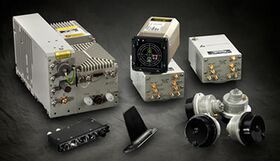Sevât-M Counter-Emissions System: Difference between revisions
Ozycaevias (talk | contribs) m (1 revision imported) |
ContraViper (talk | contribs) |
||
| (3 intermediate revisions by the same user not shown) | |||
| Line 33: | Line 33: | ||
|guidance= | |guidance= | ||
}} | }} | ||
The '''Sevât-M Counter Emissions System''' is a radar warning receiver (RWR) with secondary ELINT capabilities manufactured by Navayelle Systems, Inc. of [[Inyursta]]. It is intended for use with multirole and strike aircraft undertaking SEAD & counter-radar missions. | The '''Sevât-M Counter Emissions System''' is a radar warning receiver (RWR) with secondary ELINT capabilities manufactured by [[Navayelle Systems|Navayelle Systems, Inc]]. of [[Inyursta]]. It is intended for use with multirole and strike aircraft undertaking SEAD & counter-radar missions. | ||
"Sevât" derives from the Inyurstan word "Sevâtaire"; which roughly translates to "kickboxer" in English. | "Sevât" derives from the Inyurstan word "Sevâtaire"; which roughly translates to "kickboxer" in English. | ||
| Line 39: | Line 39: | ||
==Performance== | ==Performance== | ||
The Sevât-M | The Sevât-M syncs to built-in antennae on the the host aircraft which detect active radar emissions from aircraft, ships, ground systems and radar-guided missiles. It's software records emission type (X-band, K-band, etc.) and uses an algorithm which measures output, power, etc. to gauge the range of the source; and displays this information on the pilot's HUD. | ||
It also allows for easier tracking and targeting of compatible anti-radiation missiles (ARMs), such as the [[OCE-1 Chaos|OCE-1 Block III]] and [[OCE-3 Entropéa]], directly sharing information with the pilot or copilot's weapons targeting systems. | |||
Detection and tracking range depends on several factors, including bandwidth, output, environment clutter, speed of source, number of host aircraft antennae etc.; but the Sevât-M CES offers significant detection range and target use identification over previous RWR systems. | |||
It can also be synced to infrared or electro-optical missile launch detectors (MLD) in compatible aircraft. Modular Receiver Antennae (MRAs) can be added to platforms without existing RWR infrastructure, allowing simplistic warning and targeting capabilities. | |||
==Host Platforms== | ==Host Platforms== | ||
Current: | Current: | ||
*[[ | *[[AC/A-92 Night Adder]] | ||
*[[Amérifighter EF-20]] | *[[Amérifighter EF-20]] | ||
*[[AC/A-85 Cantíl]] | |||
Under Testing: | Under Testing: | ||
*{{wp|Sikorsky UH-60 Blackhawk|UH-60}} | *{{wp|Sikorsky UH-60 Blackhawk|UH-60}} | ||
Latest revision as of 22:16, 13 March 2022
| Sevât-M Counter-Emissions System | |
|---|---|
 Sevât-M CES | |
| Type | Radar Warning Receiver (RWR) & ELINT Device |
| Place of origin | |
| Production history | |
| Designer | Navayelle Systems |
The Sevât-M Counter Emissions System is a radar warning receiver (RWR) with secondary ELINT capabilities manufactured by Navayelle Systems, Inc. of Inyursta. It is intended for use with multirole and strike aircraft undertaking SEAD & counter-radar missions.
"Sevât" derives from the Inyurstan word "Sevâtaire"; which roughly translates to "kickboxer" in English.
Performance
The Sevât-M syncs to built-in antennae on the the host aircraft which detect active radar emissions from aircraft, ships, ground systems and radar-guided missiles. It's software records emission type (X-band, K-band, etc.) and uses an algorithm which measures output, power, etc. to gauge the range of the source; and displays this information on the pilot's HUD. It also allows for easier tracking and targeting of compatible anti-radiation missiles (ARMs), such as the OCE-1 Block III and OCE-3 Entropéa, directly sharing information with the pilot or copilot's weapons targeting systems. Detection and tracking range depends on several factors, including bandwidth, output, environment clutter, speed of source, number of host aircraft antennae etc.; but the Sevât-M CES offers significant detection range and target use identification over previous RWR systems.
It can also be synced to infrared or electro-optical missile launch detectors (MLD) in compatible aircraft. Modular Receiver Antennae (MRAs) can be added to platforms without existing RWR infrastructure, allowing simplistic warning and targeting capabilities.
Host Platforms
Current:
Under Testing: